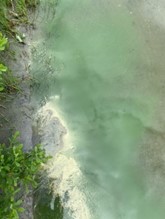Update! Cyanobacteria Advisory for Mascoma Lake Removed
FOR IMMEDIATE RELEASE
DATE: 06/10/2022
CONTACT: Kate Hastings, (603) 848-8094, HAB@des.nh.gov
des.nh.gov
twitter.com/NHDES
twitter.com/NHDES_Beaches
State Removes Cyanobacteria Advisory for Mascoma ake in Enfield and Lebanon, NH
Concord, NH- The New Hampshire Department of Environmental Services (NHDES) has REMOVED a cyanobacteria advisory for Mascoma Lake that was issued on 06/03/2022. While the bloom accumulation has dissipated, NHDES advises that lake-goers look out for green surface accumulations in the future. Please continue to monitor your individual shoreline for changing conditions.
This advisory was not based on a toxin evaluation and was intended as a precautionary measure for short term exposure. Cyanobacteria are natural components of water bodies worldwide, though blooms and surface scums may form when excess nutrients are available to the water. Some cyanobacteria produce toxins that are stored within the cells and released upon cell death. Toxins can cause both acute and chronic health effects that range in severity. Acute health effects include irritation of skin and mucous membranes, tingling, numbness, nausea, vomiting, seizures and diarrhea. Chronic effects may include liver and central nervous system damage. Be cautious of lake water that has a surface scum, changes colors, or appears to have green streaks or blue-green flecks aggregating along the shore.
The advisory went into effect on June 3, 2022 and was removed on June 10, 2022.
Visit the NHDES Harmful Algal and Cyanobacteria Bloom Program website for photos and more information about cyanobacteria at: Harmful Algal Blooms | NH Department of Environmental Services.
Check out the Beach Mapper Website and follow the Beaches Twitter feed for updates on cyanobacteria advisories.
If you notice anything resembling cyanobacteria, please refrain from wading, swimming, or drinking the water. Keep all pets out of the water and contact NHDES immediately. Please call NHDES to report a cyanobacteria bloom at (603) 848-8094 or email HAB@des.nh.gov.
# # #
FOR IMMEDIATE RELEASE
DATE: 06/03/2022
CONTACT: Kate Hastings, (603) 848-8094, HAB@des.nh.gov
des.nh.gov
twitter.com/NHDES
twitter.com/NHDES_Beaches
State Issues Cyanobacteria Bloom Advisory for Mascoma Lake in Enfield and Lebanon, NH
Concord, NH- A cyanobacteria bloom has been observed on Mascoma Lake. Thick green clouds have been observed in multiple locations across the lake covering long stretches of the shore in some places. Samples from the initial bloom material observed were analyzed 6/3/22 and cyanobacteria (Dolichospermum) were observed in concentrations up to 1,279,400 cells/mL in areas of highest observed accumulations. There was also a significant amount of pollen in the sample. Advisories are issued when cyanobacterial cell concentrations exceed 70,000 cells/ml. As a result, NHDES has issued a cyanobacteria bloom advisory for those who use the waterbody for recreation. The advisory is not based on a toxin evaluation and is intended as a precautionary measure for short term exposure.

Surface blooms can rapidly change and accumulate in various locations around a waterbody. Please continue to monitor your individual shorelines for changing conditions. NHDES advises lake users to avoid contact with the water in areas experiencing elevated cyanobacteria cell conditions, also known as a bloom. NHDES also advises pet owners to keep their pets out of any waters that have a cyanobacteria bloom.
Cyanobacteria are natural components of water bodies worldwide, though blooms and surface scums may form when excess nutrients are available to the water. Some cyanobacteria produce toxins that are stored within the cells and released upon cell death. Toxins can cause both acute and chronic health effects that range in severity. Acute health effects include irritation of skin and mucous membranes, tingling, numbness, nausea, vomiting, seizures and diarrhea. Chronic effects may include liver and central nervous system damage. Be cautious of lake water that has a surface scum, changes colors, or appears to have green streaks or blue-green flecks aggregating along the shore.
The cyanobacteria advisory went into effect on June 3, 2022 and will remain in effect until NHDES confirms that cell concentrations of the bloom have subsided.
Visit the NHDES Harmful Algal and Cyanobacterial Bloom Program website for photos and more information about cyanobacteria
Updates on cyanobacteria advisories can be found on the Beach Map
Follow NHDES_Beaches on Twitter.
If you notice anything resembling cyanobacteria, please refrain from wading, swimming, or drinking the water. Keep all pets out of the water and contact NHDES immediately. Please call NHDES to report a cyanobacteria bloom at (603) 848-8094 or email HAB@des.nh.gov.
# # #
See also this EPA publication relative to Harmful Algal Blooms (HABs)

